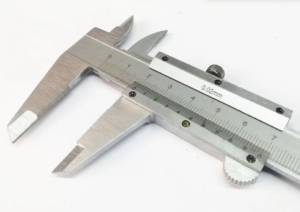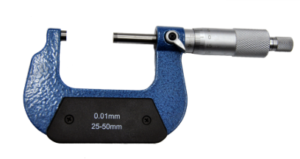What are measuring tools for cnc machines
At present, in the machining industry, precision and complex parts are mainly processed by CNC (computer numerical control). In order to ensure the size and surface finish of the parts, various measuring tools need to be used for inspection. Now, we will explore the various measuring tools used by CNC machines during machining.
Common measuring tools
1.Caliper
Calipers are versatile measuring tools for interior and exterior measurements. They come in two types: vernier calipers and digital calipers. The vernier caliper consists of a main scale and a vernier scale and can be accurate to millimeters. Digital calipers provide electronic readings. Calipers are essential for quickly verifying the dimensions of a workpiece during machining.

2.Micrometer
A micrometer consists of a spindle, anvil, and ejector pin that can be adjusted to achieve accurate readings. Micrometers can be used to measure exterior dimensions, interior dimensions, and depth. They are particularly useful for measuring diameter, length, thickness, etc.

3. Height gauge
Height rulers are used to accurately measure and mark heights, depths and steps. They consist of a base, a column and a numeric or dial indicator. The height gauge adjusts to various heights and locks into place to measure the distance between the workbench and the workpiece reference surface.

4,Thread gauge
Thread ring gauge is used to check external threads of screws, bolts, etc. It is a steel ring with a threaded inner surface that matches the specification of the required threads. When using a thread ring gauge, if the threads match perfectly, the ring gauge will slide smoothly over the object without any resistance. However, if the threads are not aligned correctly, the gauge will not fit or stick to the object, indicating that the threads are substandard.
Thread ring gauges come in various sizes and configurations to accommodate different types of threads, such as metric, imperial, uniform or pipe threads. It is an important tool for quality control, ensuring the accuracy and functionality of threaded components.

5,Thread plug gauge
Thread plug gauge is a measuring tool used to check the accuracy and quality of internal threads. Typically made from high-quality materials such as hardened steel or tungsten carbide, thread plug gauges consist of an elongated cylinder with threads carved into the outer surface.
If the gauge screws all the way in without any effort or play, the hole is within tolerance. However, if the gauge is difficult to insert or there is significant play, the hole is out of tolerance.

6,CMM
A coordinate measuring machine (CMM) is a device that measures the dimensions of parts during machining.
A CMM consists of several key components, including a large granite or cast iron base, a movable bridge or gantry, and a measuring probe.
CMM uses a combination of mechanical and optical systems to project the features of the workpiece onto a screen or monitor. The operator can then visually inspect the part. The projected image shows deviations from expected dimensions, allowing engineers to make necessary adjustments to the manufacturing process.

7.Surface roughness meter
Surface roughness meter is a device used to measure the surface roughness of various materials.
The working principle of the surface roughness meter is to use a stylus or probe to drag on the surface of the material being measured. The probe measures the vertical movement of the stylus as it encounters peaks and valleys on the surface. This data is analyzed and quantified to provide information about surface roughness. It provides accurate and repeatable measurements, allowing for precise quality control and the ability to compare surfaces to specified standards.
The measurement results are usually expressed in parameters such as Ra (arithmetic mean roughness), Rz (average peak and valley roughness), and Rt (total roughness).

Measuring tools are important measuring instruments in CNC machining and are the basis of the quality control and inspection process of processed parts. They play a key role in the size and finish of various parts. Ensure that processed parts meet customer-specified standards and requirements. This is especially important in industries where precision and accuracy are critical, such as aerospace or automotive manufacturing.

Leave a Reply
Want to join the discussion?Feel free to contribute!